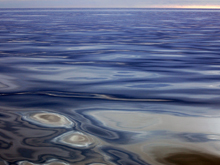
On the morning of September 16, the water surface looked like liquid metal. In fact, it was smooth enough to be classified as a "Beaufort 1" on the 1-to-12 scale describing the sea state. On such days, and especially when the sky is clear, sighting marine mammals is easiest for marine mammal observers like Sue Moore. Click image for larger view and image credit.
Watching for Marine Mammals
September 21, 2009
Sue Moore
Research Scientist
NOAA/Fisheries Office of Science and Technology
Lucky 13: the only sighting of bowhead whales on the RUSALCA cruise so far occurred the morning of September 13, the 11th day of the mission. The ship had just passed a narrow ribbon of sea ice in the north-central Chukchi Sea, a strip about 1 kilometer (0.5 miles) long on which roughly 80 walrus were hauled out. The ice was stained brown where walrus had been resting, and was browner still where tens of animals were "stacked" upon one another on the tiny bits of ice in the vast gray sea. I was pleased to see these floating wayfarers, as sightings of marine mammals have been few and far between on this trip. But, I was happier still when, roughly 16 km (10 miles) north of the walrus, there appeared the shiny-black "cone heads" of three bowhead whales — my principal quarry.
I am conducting a marine mammal watch on the RUSALCA cruise. As a single observer, I maintain a look-out for mammals forward of the ship while it is underway between stations, and I scan the perimeter of the ship when it is stopped at stations. This single-person effort provides a rare opportunistic look for marine mammals on the western side of the international date line. It contrasts with standard visual surveys for marine mammals, which consist of a data recorder and two observers stationed at pedestal-mounted Big Eye binoculars that are mounted on the flying bridge of the ship. Still, the opportunity to watch for mammals in conjunction with the ongoing bio-oceanographic sampling during the RUSALCA mission is unprecedented.
While bowhead whales are the prime target of my search, I am recording positions for all marine mammals, along with associated environmental data such as sea ice cover, weather, and visibility range. The first full day of our mission was a real "Whale Bonanza," when I counted 101 gray whales and 21 humpback whales at a hot spot in the south-central Chukchi Sea. I began counting whales at first light, so had a running total of nearly 80 whales in the two-hour transit to the station where a full suite of biological sampling meant that we remained there over seven hours. While stopped, I was able to sketch out the distribution pattern of gray and humpback whales in the immediate vicinity of the ship while watching them dive, time and again, to feed in the productive arctic waters. Later in the cruise, seven gray whales were seen feeding in the East Siberian Sea and four more were sighted north of Wrangel Island. These sightings are a first for these waters, likely related to the extreme retreat of sea ice that allows whales to go prospecting for food in new areas.
No matter that the marine mammal sighting rate has been low on this mission; the days when I can stand on the flying bridge and simply enjoy being in the Arctic are a privilege. Early this morning, the sky was shades of deep purple, blue, and gray as the sun rose like an orange dragon's eye between a gray sea and low-overcast sky. There were rafts and rafts of hundreds of short-tailed shearwaters (a type of seabird) bobbing like black dots on the water. A wild splashing disturbance in one group caused by a walrus surfacing up through their midst caught my eye. I could not tell if the walrus was trying to catch a bird (there are reports of such behavior), but on a second rise the animal seemed to look right at me and, with a glint off his tusks, sunk back under the waves — seemingly embarrassed to be caught "birding" rather than diving for clams.
This spectacle of wildlife, whether seabirds or mammals, is simply good for the soul and makes one happy to be alive on a gray-damp morning east of Herald Island in the northern Chukchi Sea.















